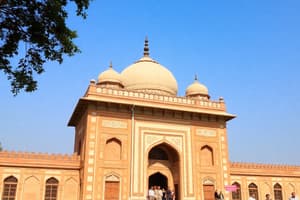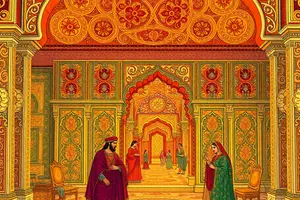Podcast
Questions and Answers
Who was the last of the powerful Mughal rulers?
Who was the last of the powerful Mughal rulers?
- Shah Jahan
- Bahadur Shah I
- Akbar
- Aurangzeb (correct)
The British initially came to India as a ruling power.
The British initially came to India as a ruling power.
False (B)
What was Clive's promise to secure support during the conflict with Sirajuddaulah?
What was Clive's promise to secure support during the conflict with Sirajuddaulah?
- To provide military support
- To make him nawab (correct)
- To share the wealth
- To make him the king
What significant change occurred in the political landscape of India after Aurangzeb's death in 1707?
What significant change occurred in the political landscape of India after Aurangzeb's death in 1707?
After Aurangzeb's death, many Mughal governors began asserting their _____ over various regions.
After Aurangzeb's death, many Mughal governors began asserting their _____ over various regions.
The Battle of Plassey was the first major victory for the East India Company in India.
The Battle of Plassey was the first major victory for the East India Company in India.
Match the following Mughal emperors with their significance:
Match the following Mughal emperors with their significance:
Who was made nawab after the defeat of Sirajuddaulah?
Who was made nawab after the defeat of Sirajuddaulah?
What was one of the main reasons Delhi could no longer function effectively as a center of power?
What was one of the main reasons Delhi could no longer function effectively as a center of power?
Robert Clive wrote a letter to _____ on 7 January 1759.
Robert Clive wrote a letter to _____ on 7 January 1759.
What was the annual income projected by Clive from the conquered territories?
What was the annual income projected by Clive from the conquered territories?
By the second half of the eighteenth century, the British were becoming a new power in India.
By the second half of the eighteenth century, the British were becoming a new power in India.
Sirajuddaulah was spared after the Battle of Plassey.
Sirajuddaulah was spared after the Battle of Plassey.
Who was arrested by Captain Hodson according to the historical context presented?
Who was arrested by Captain Hodson according to the historical context presented?
What key concern did Clive express about the East India Company's expansion?
What key concern did Clive express about the East India Company's expansion?
Match the following individuals with their roles during the Battle of Plassey:
Match the following individuals with their roles during the Battle of Plassey:
What term was used to describe the anglicised version of the Indian word 'nawab'?
What term was used to describe the anglicised version of the Indian word 'nawab'?
The East India Company often used direct military attacks to annex Indian states.
The East India Company often used direct military attacks to annex Indian states.
What role did the Residents appointed by the East India Company serve in Indian states?
What role did the Residents appointed by the East India Company serve in Indian states?
The process of annexation by the East India Company primarily occurred between _____ and _____ years.
The process of annexation by the East India Company primarily occurred between _____ and _____ years.
Match the following actions with their descriptions:
Match the following actions with their descriptions:
What was a common perception of the 'nabobs' in British society?
What was a common perception of the 'nabobs' in British society?
The Battle of Buxar took place in 1764.
The Battle of Buxar took place in 1764.
What did the East India Company focus on before annexing an Indian kingdom?
What did the East India Company focus on before annexing an Indian kingdom?
What was the primary perception of Haidar and Tipu by the British?
What was the primary perception of Haidar and Tipu by the British?
Tipu Sultan was killed in the first battle fought with the British.
Tipu Sultan was killed in the first battle fought with the British.
In which year did Tipu Sultan become the ruler of Mysore?
In which year did Tipu Sultan become the ruler of Mysore?
The last battle fought with Mysore was known as the Battle of ______.
The last battle fought with Mysore was known as the Battle of ______.
How many wars were fought between the British and Mysore?
How many wars were fought between the British and Mysore?
What happened to Mysore after the death of Tipu Sultan?
What happened to Mysore after the death of Tipu Sultan?
Match the following battles with their respective years:
Match the following battles with their respective years:
The French played no role in modernizing Tipu Sultan's army.
The French played no role in modernizing Tipu Sultan's army.
How did the assumption of Diwani primarily benefit the East India Company?
How did the assumption of Diwani primarily benefit the East India Company?
The system of 'subsidiary alliance' was primarily aimed at strengthening the military power of Indian rulers.
The system of 'subsidiary alliance' was primarily aimed at strengthening the military power of Indian rulers.
What were some changes that occurred in the composition of the Company's army during the colonial period?
What were some changes that occurred in the composition of the Company's army during the colonial period?
The city of Calcutta developed from a small village into a major city after the _____ conquest of Bengal.
The city of Calcutta developed from a small village into a major city after the _____ conquest of Bengal.
Match the rulers with their significance:
Match the rulers with their significance:
Flashcards are hidden until you start studying
Study Notes
The End of the Mughal Empire
- Aurangzeb, the last significant Mughal ruler, expanded control over large parts of India.
- After his death in 1707, power fragmentation led to the rise of regional kingdoms, undermining Delhi's authority.
- By the late 18th century, British influence began to overshadow regional powers as they expanded their control.
Rise of the British East India Company
- Initially, the British East India Company focused on trade, showing reluctance to acquire territories.
- The Battle of Plassey in 1757 marked the Company's first major military success, leading to territorial expansion.
- The aftermath of Plassey allowed Robert Clive to promise support to Mughal emperors as a means to consolidate power.
Transition to Power
- The assassination of Sirajuddaulah after the Battle of Plassey led to Mir Jafar being installed as nawab.
- "Nabobs," former Indian rulers now serving British interests, were viewed with suspicion and ridicule in British society.
Expansion Tactics of the Company
- The East India Company used political, economic, and diplomatic strategies rather than direct military confrontation to annex states.
- Following the Battle of Buxar in 1764, the Company established political agents called Residents to oversee regional affairs.
- Residents interfered in the internal matters of Indian kingdoms to promote the Company's interests.
Conflicts with Mysore
- Tensions arose with Haidar Ali and his son, Tipu Sultan, viewed as threats by the British.
- Four significant wars with Mysore occurred between 1767 and 1799, culminating in Tipu Sultan's defeat and death in 1799 at the Battle of Shrirangapatnam.
The Company’s Administration
- The Company's governance differed from traditional Indian administration, utilizing a system of subsidiary alliances to exert control.
- This system involved local rulers maintaining their positions under British oversight, entrenching British authority over Indian affairs.
Cultural Shifts in Bengal
- Post conquest of Bengal, Calcutta transitioned from a small village to a major city, marked by significant cultural and architectural developments.
- The period witnessed a blend of European and Indian lifestyles, with changes in societal structures reflecting colonial influences.
Studying That Suits You
Use AI to generate personalized quizzes and flashcards to suit your learning preferences.




